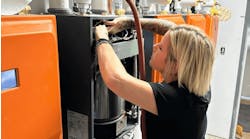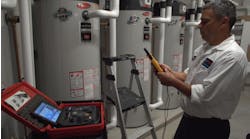Whether you’re phasing out the last few inefficient restroom fixtures in your facility or just replacing yesterday’s efficient models as they reach the end of their useful life, you can make the process relatively hassle-free by reviewing your options and approaching the selection process in a methodical manner. Try these three simple tips for implementing low-flow fixtures in your facility’s washrooms.
1) Fit the Fixtures to Your Facility
There are a number of options on the market that can help reduce water use in your washrooms depending on your needs and what you’re comfortable with. Fixture styles include:
Toilets: There are three key toilet styles to choose from. High-efficiency toilets typically use around 1.3 gallons per flush (gpf), which is 20% less than the current standard of 1.6 gpf. Look for models that are certified by the EPA’s WaterSense program or Maximum Performance (MaP). Dual-flush models provide two options for flushing; the liquid waste option, which consumes 0.8-1.1 gpf, and the solid waste option, which uses 1.3-1.6 gpf. Pressure-assist toilets push water and waste down the drain with a pressurization system and use roughly 0.8-1 gpf.
Urinals: Choose between waterless and low-flow models. Waterless models rely on gravity to drain urine through a sealing liquid that traps odors, whereas low-flow urinals are styled more like conventional urinals and simply do the same rinsing job with less water. Some models on the market use as little as 1 pint of water per flush (0.125 gpf), saving 87% over the minimum standard of 1 gpf.
Sinks: Simple aerators can be installed on many faucets to reduce the amount of water coming out. They can cut water use by up to 75%, which can provide a quick payback. If you’re looking to replace the whole unit, consider a touchless faucet that automatically starts flowing when it senses hands beneath it, eliminating the possibility that someone will leave it running.
2) Compare with Similar Buildings
Reach out to fellow FMs who have recently completed similar projects to get an idea of their costs and resulting savings. Speaking to colleagues in your area is ideal as you know they more than likely pay the same utility rates you do.
For example, one wide-ranging project in Culver City, CA, replaced 206 toilet flushometers (which used 3.5 gpf each) with 1.6/1.1 dual-flush diaphragms, as well as installing waterless urinals in place of 25 conventional 1 gpf urinals. The city wanted to be proactive in light of the statewide drought and shortage of potable water, and it paid off – a three-month study of six of the city’s largest buildings revealed a 43% water savings at City Hall, 41% at the senior center and 25% at the police station.
3) Retrain Staff on Maintenance
Review the recommended maintenance schedule and procedures with your facilities staff, especially if you’re installing an unfamiliar fixture style like a waterless urinal. For instance, it may seem logical to pour excess water into the urinal trap, but it can actually flush the sealant out of the trap insert, so it’s important that your staff knows to just wipe it down per the included instructions instead. The manufacturer may also recommend specific cleaner types or strategies. Conscientious choices and careful attention to maintenance will ensure that you get the most value and the longest life out of your new fixtures.


